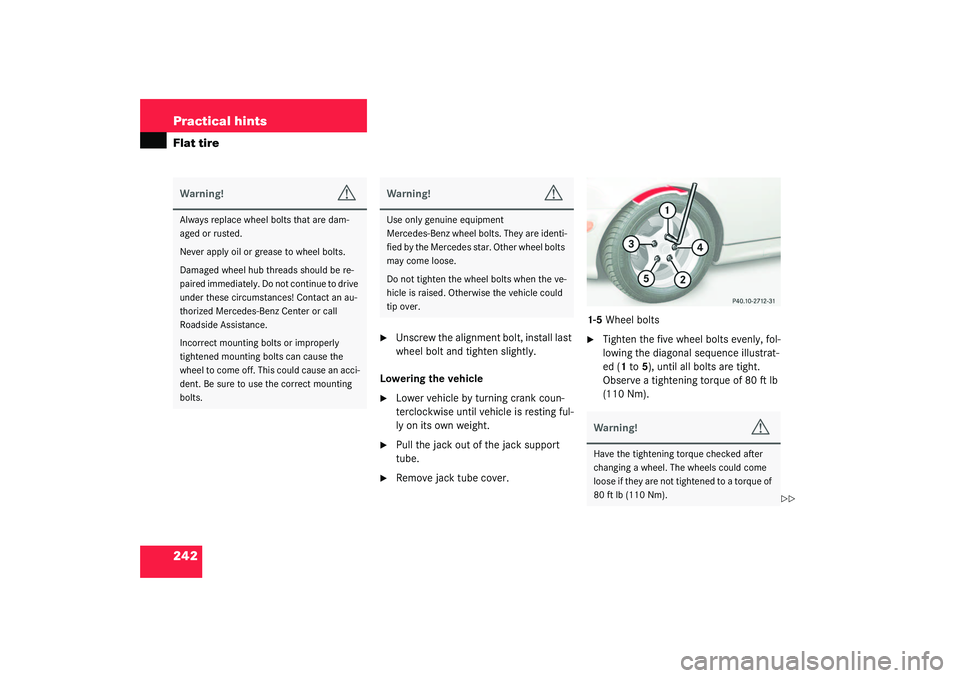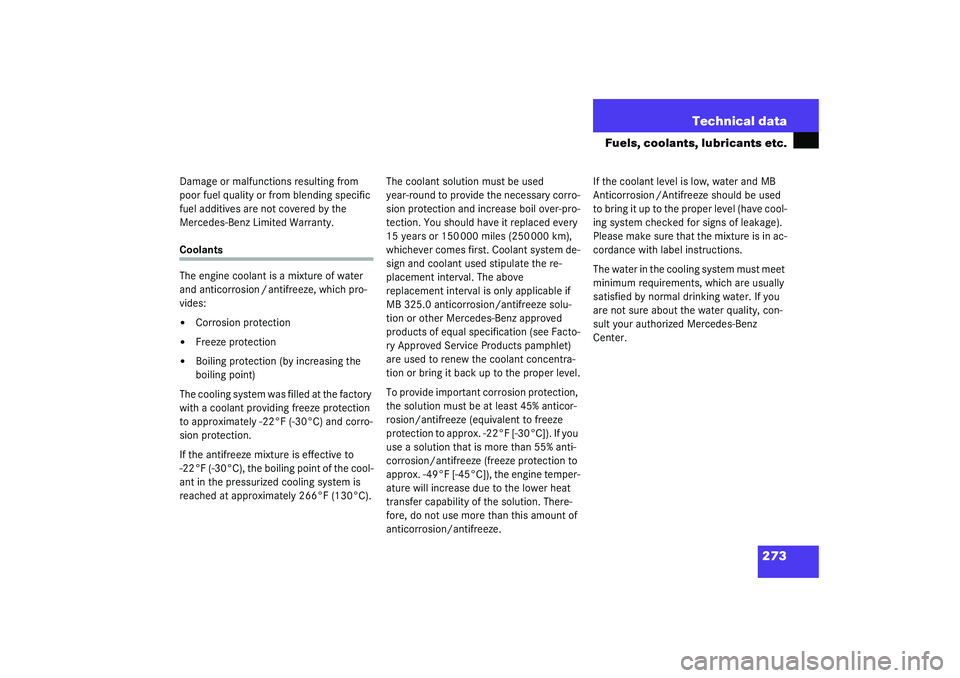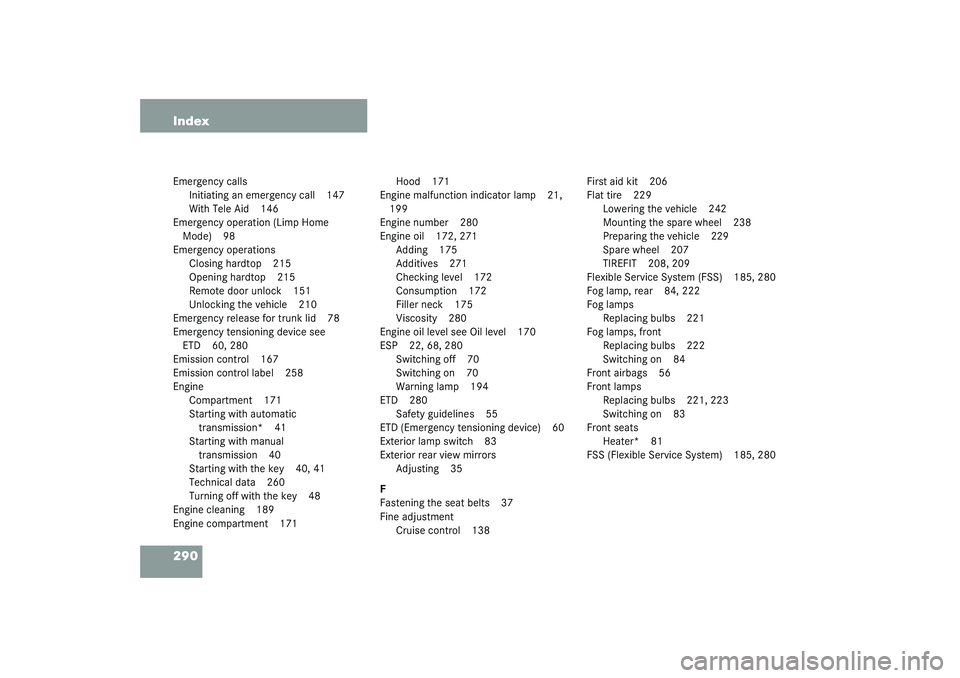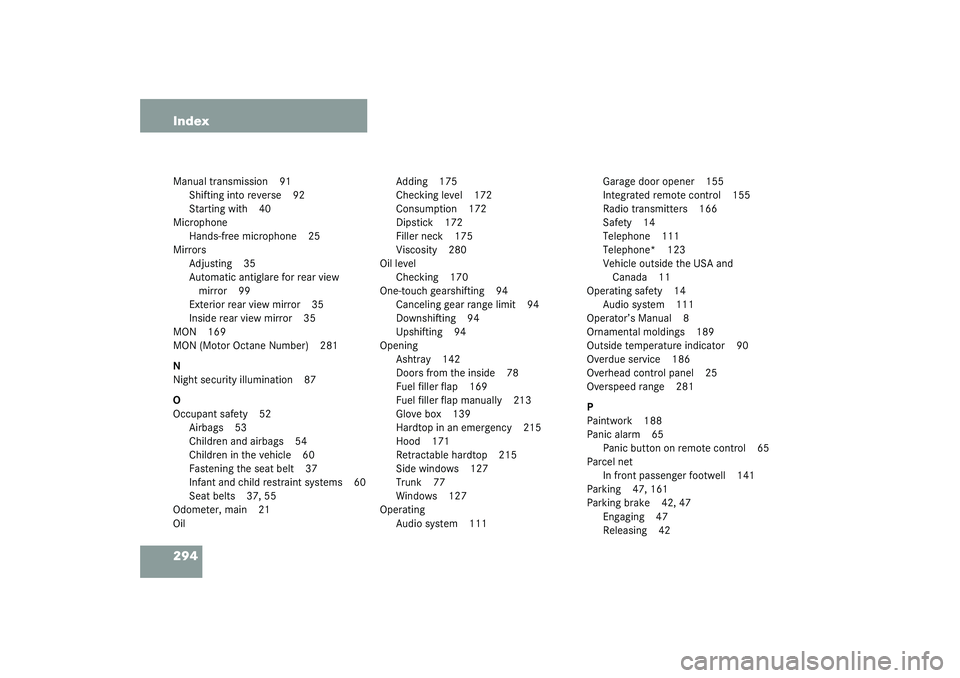Page 242 of 304

242 Practical hintsFlat tire
�
Unscrew the alignment bolt, install last
wheel bolt and tighten slightly.
Lowering the vehicle
�
Lower vehicle by turning crank coun-
terclockwise until vehicle is resting ful-
ly on its own weight.
�
Pull the jack out of the jack support
tube.
�
Remove jack tube cover.1-5Wheel bolts
�
Tighten the five wheel bolts evenly, fol-
lowing the diagonal sequence illustrat-
ed (1to5), until all bolts are tight.
Observe a tightening torque of 80 ft lb
(110 Nm).
Warning!
G
Always replace wheel bolts that are dam-
aged or rusted.
Never apply oil or grease to wheel bolts.
Damaged wheel hub threads should be re-
paired immediately. Do not continue to drive
under these circumstances! Contact an au-
thorized Mercedes-Benz Center or call
Roadside Assistance.
Incorrect mounting bolts or improperly
tightened mounting bolts can cause the
wheel to come off. This could cause an acci-
dent. Be sure to use the correct mounting
bolts.
Warning!
G
Use only genuine equipment
Mercedes-Benz wheel bolts. They are identi-
fied by the Mercedes star. Other wheel bolts
may come loose.
Do not tighten the wheel bolts when the ve-
hicle is raised. Otherwise the vehicle could
tip over.
Warning!
G
Have the tightening torque checked after
changing a wheel. The wheels could come
loose if they are not tightened to a torque of
80 ft lb (110 Nm).
��
Page 273 of 304

273 Technical data
Fuels, coolants, lubricants etc.
Damage or malfunctions resulting from
poor fuel quality or from blending specific
fuel additives are not covered by the
Mercedes-Benz Limited Warranty.Coolants
The engine coolant is a mixture of water
and anticorrosion / antifreeze, which pro-
vides:�
Corrosion protection
�
Freeze protection
�
Boiling protection (by increasing the
boiling point)
The cooling system was filled at the factory
with a coolant providing freeze protection
to approximately -22°F (-30°C) and corro-
sion protection.
If the antifreeze mixture is effective to
-22°F (-30°C), the boiling point of the cool-
ant in the pressurized cooling system is
reached at approximately 266°F (130°C).The coolant solution must be used
year-round to provide the necessary corro-
sion protection and increase boil over-pro-
tection. You should have it replaced every
15 years or 150 000 miles (250 000 km),
whichever comes first. Coolant system de-
sign and coolant used stipulate the re-
placement interval. The above
replacement interval is only applicable if
MB 325.0 anticorrosion/antifreeze solu-
tion or other Mercedes-Benz approved
products of equal specification (see Facto-
ry Approved Service Products pamphlet)
are used to renew the coolant concentra-
tion or bring it back up to the proper level.
To provide important corrosion protection,
the solution must be at least 45% anticor-
rosion/antifreeze (equivalent to freeze
protection to approx. -22°F [-30°C]). If you
use a solution that is more than 55% anti-
corrosion/antifreeze (freeze protection to
approx. -49°F [-45°C]), the engine temper-
ature will increase due to the lower heat
transfer capability of the solution. There-
fore, do not use more than this amount of
anticorrosion/antifreeze.If the coolant level is low, water and MB
Anticorrosion /Antifreeze should be used
to bring it up to the proper level (have cool-
ing system checked for signs of leakage).
Please make sure that the mixture is in ac-
cordance with label instructions.
The water in the cooling system must meet
minimum requirements, which are usually
satisfied by normal drinking water. If you
are not sure about the water quality, con-
sult your authorized Mercedes-Benz
Center.
Page 287 of 304

287 Index
Battery discharged
Jump starting 247
Battery, vehicle 178, 245
Charging 246
Disconnecting 246
Reconnecting 246
Reinstalling 246
Removing 246
Block heater 184
Bolts
For spare wheel 207
Brake assist system (BAS) 279
Brake fluid 170, 271
Brake lamp bulbs 222
Brake lamp, high mounted 222
Brakes 160
Warning lamp 198
Break-in period 158
Bulbs, replacing 221
Additional turn signals 221
Backup lamps 222
Brake lamps 222
Fog lamps 221
Front lamps 221
High beam 221
High mounted brake lamp 222License plate lamps 222, 226
Low beam 221
Parking lamps 221, 222, 224
Rear fog lamp 222
Rear fog lamps 225
Side marker lamps 221, 225
Standing lamps 221, 222, 224
Tail lamp assemblies 222, 225
Turn signal lamps 221, 222
Xenon* headlamps 223
Button
Audio system 115
C
CAC (Customer Assistance Center) 279
California
Important notice 9
Calling up
Service indicator 186
CAN system 279
Capacities
Fuels, coolants, lubricants, etc. 269
Cargo area see Cargo compartment 77
Cargo compartment
Trunk 77
Casette mode
Playing cassettes 118Catalytic converter 166
CD changer* 120, 209
CD mode 120
Center console 23
AIRBAG OFF indicator lamp 205
Lower part 24
Storage compartment 140
Upper part 23
Central locking
From inside 80
Unlocking from inside 80
Certification label 258
Changing CDs 120
Charging
Vehicle battery 246
CHECK ENGINE malfunction indicator
lamp 199
Checking
Coolant level 170, 176
Oil level 170, 172
Tire inflation pressure 170
Vehicle lighting 170
Checking engine oil level
Via engine oil level indicator 173
Via oil dipstick 173
Page 290 of 304

290 IndexEmergency calls
Initiating an emergency call 147
With Tele Aid 146
Emergency operation (Limp Home
Mode) 98
Emergency operations
Closing hardtop 215
Opening hardtop 215
Remote door unlock 151
Unlocking the vehicle 210
Emergency release for trunk lid 78
Emergency tensioning device see
ETD 60, 280
Emission control 167
Emission control label 258
Engine
Compartment 171
Starting with automatic
transmission* 41
Starting with manual
transmission 40
Starting with the key 40, 41
Technical data 260
Turning off with the key 48
Engine cleaning 189
Engine compartment 171Hood 171
Engine malfunction indicator lamp 21,
199
Engine number 280
Engine oil 172, 271
Adding 175
Additives 271
Checking level 172
Consumption 172
Filler neck 175
Viscosity 280
Engine oil level see Oil level 170
ESP 22, 68, 280
Switching off 70
Switching on 70
Warning lamp 194
ETD 280
Safety guidelines 55
ETD (Emergency tensioning device) 60
Exterior lamp switch 83
Exterior rear view mirrors
Adjusting 35
F
Fastening the seat belts 37
Fine adjustment
Cruise control 138First aid kit 206
Flat tire 229
Lowering the vehicle 242
Mounting the spare wheel 238
Preparing the vehicle 229
Spare wheel 207
TIREFIT 208, 209
Flexible Service System (FSS) 185, 280
Fog lamp, rear 84, 222
Fog lamps
Replacing bulbs 221
Fog lamps, front
Replacing bulbs 222
Switching on 84
Front airbags 56
Front lamps
Replacing bulbs 221, 223
Switching on 83
Front seats
Heater* 81
FSS (Flexible Service System) 185, 280
Page 294 of 304

294 IndexManual transmission 91
Shifting into reverse 92
Starting with 40
Microphone
Hands-free microphone 25
Mirrors
Adjusting 35
Automatic antiglare for rear view
mirror 99
Exterior rear view mirror 35
Inside rear view mirror 35
MON 169
MON (Motor Octane Number) 281
N
Night security illumination 87
O
Occupant safety 52
Airbags 53
Children and airbags 54
Children in the vehicle 60
Fastening the seat belt 37
Infant and child restraint systems 60
Seat belts 37, 55
Odometer, main 21
OilAdding 175
Checking level 172
Consumption 172
Dipstick 172
Filler neck 175
Viscosity 280
Oil level
Checking 170
One-touch gearshifting 94
Canceling gear range limit 94
Downshifting 94
Upshifting 94
Opening
Ashtray 142
Doors from the inside 78
Fuel filler flap 169
Fuel filler flap manually 213
Glove box 139
Hardtop in an emergency 215
Hood 171
Retractable hardtop 215
Side windows 127
Trunk 77
Windows 127
Operating
Audio system 111Garage door opener 155
Integrated remote control 155
Radio transmitters 166
Safety 14
Telephone 111
Telephone* 123
Vehicle outside the USA and
Canada 11
Operating safety 14
Audio system 111
Operator’s Manual 8
Ornamental moldings 189
Outside temperature indicator 90
Overdue service 186
Overhead control panel 25
Overspeed range 281
P
Paintwork 188
Panic alarm 65
Panic button on remote control 65
Parcel net
In front passenger footwell 141
Parking 47, 161
Parking brake 42, 47
Engaging 47
Releasing 42